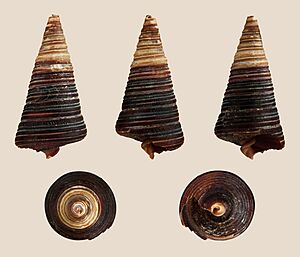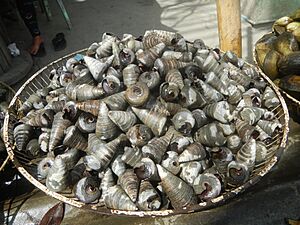Telescope snail facts for kids
Quick facts for kids Telescope snail |
|
|---|---|
 |
|
| Five views of a shell of Telescopium telescopium | |
| Scientific classification | |
| Genus: |
Telescopium (gastropod)
|
| Species: |
telescopium
|
| Synonyms | |
|
|
The Telescopium telescopium, also known as the telescope snail, is a type of snail. It belongs to the horn snail family Potamididae. You can find these snails in mangrove forests in the Indo-Pacific region. They are quite large, growing up to 8 to 10 centimeters (about 3 to 4 inches) long. Their cone-shaped shell makes them easy to spot.
People in parts of Southeast Asia eat telescope snails. In the Philippines, they are called bagongon or bagungon. In Malaysia, Singapore, and Indonesia, they are known as rodong or berongan.
Contents
What Does the Telescope Snail Look Like?
Telescopium telescopium snails look a lot like other snails in the Potamididae family. But there are a few key differences. They are the largest in their family. They also have a special fold on the inside of their shell, called the columella.
These snails have a thick, heavy shell that can be 8 to 13 centimeters (about 3 to 5 inches) long when fully grown. The shell's opening is straight, giving it a cone shape. Unlike most other snail shells, the Telescopium telescopium shell contains a small amount of magnesium carbonate, a special mineral. The shell also has a lid, called an operculum, which closes tightly.
The shells of Telescopium telescopium are usually black or very dark reddish-brown. However, they are often covered in barnacles and mud, which can hide their natural color.
Outside of its shell, the Telescopium telescopium snail is black. It has a long snout, called a proboscis. It also has three eyes: one on the edge of its shell and two near its snout.
How Telescope Snails Breathe and Eat
The Telescopium telescopium breathes like other snails that live near tides. It gets oxygen from water flowing over its small gills, which are inside its shell. When the tide goes out, the snail pulls back into its shell. This helps it save energy and oxygen until the tide comes back in. They can store oxygen for at least 36 hours, and sometimes up to 48 hours, before they need more.
The snail's digestive system starts at its snout. It uses its snout to collect food, which is rich in organic matter. This food then travels down its esophagus to its stomach. The Telescopium telescopium has a large stomach with a special part that holds a rod of digestive enzymes. These enzymes help break down algae and other organic material the snail eats.
How Telescope Snails Move
Like all snails, the Telescopium telescopium moves using a single foot that sticks out from its shell's opening. It moves by making waves of muscle contractions along the bottom of its foot. This pushes the snail forward. The foot also produces a sticky substance called pedal mucus. This mucus helps the snail stick to surfaces, even upside down, and prevents it from falling. This is how Telescopium telescopium can stay in place during high tide in mangrove areas.
Where Do Telescope Snails Live?
Telescopium telescopium snails live naturally in mangrove forests along the Indo-Western Pacific Ocean. They are also found on the Indian Ocean islands of Madagascar and Réunion. You'll mostly find them under the muddy surface of mangrove shores and on mud-flats that are just covered at high tide. Sometimes, they even wander beyond the tide line.
Sadly, the number of Telescopium telescopium snails is decreasing around the world. This is because their homes are being lost due to marine pollution and the cutting down of mangroves (deforestation).
Because they love mangroves, Telescopium telescopium snails are found in many places, including:
- Goa, India
- Chantaburi Prov., SE Thailand
- Panglao, Philippines
- Queensland, Australia
- Northern Territory, Australia
- Western Australia
- Singapore
- Madagascar
- Réunion Island
- Cambodia
- Indonesia
- Iran
- Malaysia
- Vietnam
- Papua New Guinea
Life Cycle of the Telescope Snail
Female telescope snails lay their eggs from an opening on the right side of their foot. Scientists are still learning about how long they are pregnant.
The baby snails hatch as tiny larvae in the water. They eat very small plants called phytoplankton. Before they become full-grown adults, they first change from larvae into young snails called veligers.
As they grow, Telescopium telescopium snails get longer by about 5 to 40 millimeters (0.2 to 1.6 inches) each year until they reach their adult size. These snails can live for up to 4 years.
What Do Telescope Snails Eat?
Telescopium telescopium snails are detritivores. This means they eat dead and decaying organic matter. They get most of their food from the floor of mangrove forests. They feed on the rich decomposed material left behind when the tide goes out, and also on surface algae. They only look for food when they are fully or partly covered by water, or with just their shell tips showing. This helps protect them from heat, drying out, and predators.
Telescope snails eat mangrove mud and leaves to get important bacteria they need to stay healthy.
How Humans Use Telescope Snails
Telescopium telescopium snails are now being used as bio monitors. This means they help scientists check for levels of metals like copper (Cu), zinc (Zn), and lead (Pb) in tropical areas where the land meets the sea (intertidal regions). Over their lives, parts of the snails' soft bodies and their shells collect these tiny amounts of metals. Scientists then measure these amounts to see how much pollution is in the environment.
The main parts of the Telescopium telescopium used for this are their digestive organ and their shell. The shell is good for checking lead levels because it collects more lead than any soft body part. The digestive organ is used for zinc because it collects more zinc. Other soft body parts like the foot, tentacles, mantle, muscle, and gills can also be used to monitor copper, zinc, and lead.
For example, in 2013, Telescopium telescopium snails were used in Darwin, Australia. They helped detect levels of nitrogen and carbon from the city's sewage. The test worked well, showing a clear link between these elements in the snail's body and in the mud where they lived.
In 2010, Telescopium telescopium snails were used in India to monitor iron (Fe), magnesium (Mg), zinc (Zn), and copper (Cu). The levels of these metals in the snails' bodies and shells matched the levels in the mud. This helped the Veller Estuary region in India find new ways to reduce pollution.
Telescope Snails as Food
Telescopium telescopium snails are traditional food in parts of Southeast Asia, especially Singapore. Before eating, they need to be steamed and are often served with chilli.
They are the only known type of Potamididae snail eaten by Aboriginal Australians. They are seen as a special treat because they are rare. They are lightly roasted, steamed, or boiled before eating. People living along the coast of the Northern Territory sometimes called them "poor man's tucker." This was because there were many other types of shellfish available that were considered more special.
When eaten, Telescopium telescopium snails do not have much protein. They have a peppery taste.
Before cooking, people usually break the top part of the shell. This stops the shell from exploding due to pressure buildup during cooking. After cooking, the inside of the snail often falls out of the shell. If not, a stick can be used to get the meat out.
Telescope snails are also sometimes used as bait for fishing. Their shells can be used to make lime.
Scientists are also studying if eating Telescopium telescopium tissue could have effects on the central nervous system. This research is still ongoing, but early tests on animals showed some effects. These snails are also used to make some asthma medications.
Studies have also looked at using crushed Telescopium telescopium shell powder to clean dirty water. The shell powder can act as an adsorbent to reduce copper in wastewater. These tests showed that the shell powder could be a cheap way to help clean water.


